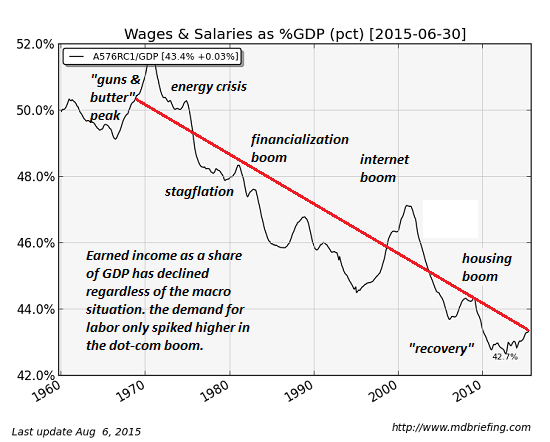Charles Hugh Smith combines the best graphs on the declining wage share of GDP in this post. He answers the question if the tax cuts and more federal borrowing and spending can solve what is broken in the U.S. economy.
Solutions abound, but not within our centralized state-cartel neofeudal system.
|
Not to rain on the new administration’s parade, but one question needs to be asked of any new administration: will tax cuts and more federal borrowing/ spending fix what’s broken in the U.S./global economy?
The short answer: if tax cuts and more federal borrowing/ spending were the cure for what ails the economy, we’d have reached Paradise long ago. Stripped of partisan politics and rah-rah, tax cuts and more federal borrowing/ spending–on infrastructure, education, defense, healthcare, you name it–have been the de facto status quo policies of both parties for the past 70 years.
Despite decades of these centralized, standard-issue Keynesian “fixes,” the economy’s structural ills are only getting worse. I outlined five of the most critical issues in What Have the “Experts” Gotten Right? In the Real Economy, They’re 0 for 5 (December 20, 2016).
|
|
|
Ultimately, two dynamics will dominate everything else: the paid work/earnings of non-elites and the transition from wasteful, debt-funded “growth” to a sustainable “Degrowth” economy.
45 years of Keynesian “stimulus”–tax cuts and federal borrowing/ spending–haven’t stemmed the decline of labor’s share of the economy (GDP). As these charts reveal, if labor’s share of the economy was still at 50% rather than 42%, households with earnings from work would be getting an astounding $1.35 trillion more per year.
This equates to an additional $10,800 per household, per year (there are roughly 125 million households in the U.S.) or about $100,000 per household per decade.
|
|
|
Would you be better off if your household had been paid an extra $100,000 in the 10 years since 2007? I am guessing the answer is “yes.”
Is it mere coincidence that while labor’s share of GDP declined by $1.35 trillion, corporate profits rose from $400 billion annually to $1.8 trillion? Garsh, do you reckon there’s a connection?
|
|
|
Another factor is the top 5%’s rising share of earnings. I call this the since I’m doing well, the economy is swell syndrome. The top 5% dominate the managerial class in the media, government, think tanks, foundations and corporate America, and from their perch high atop the centralized pyramid of wealth/power in America, things look just grand.
|
Things look considerably different from the bottom of the pyramid.
The Powers That Be have three basic fixes for every systemic ill:
1. Concentrate even more power and wealth in the central state
2. Borrow and blow a couple more trillion dollars
3. Guaranteed minimum income for the bottom 95%, which is a politically correct code phrase for:
We’re tossing you on the trash heap of society, making sure you have just enough cash to get to the dollar store or Wal-Mart and enough to scrape by so you won’t rise up against your “betters” who own all the wealth and income streams.
Sorry, but I think we can do better. In terms of aligning social-economic policy with the emerging economy, I think the real solutions are:
1. Decentralize / devolve power to regional metro areas, cities, towns, communities and neighborhoods. I explain how this works in my book Resistance, Revolution, Liberation: A Model for Positive Change.
I’m not alone in seeing this as the only solution that aligns with the emerging economy. Consider The Most Disruptive Transformation in History: How the clustering of knowledge lays bare the need to devolve power from the nation-state to the city.
2. Align our educational system with the emerging economy and reduce the cost of higher education by 90%. Yes, I know, it can’t be done, blah blah blah, we need our buggy whip industry, we’ll perish without it, Baumol’s Disease, etc. etc. etc.
I explain how to revolutionize education in my book The Nearly Free University and the Emerging Economy.
3. Transform our sick, centralized culture of consumption to a vibrant healthy culture of productive entrepreneurism. As you have probably guessed, I lay out how to do this in my book Get a Job, Build a Real Career and Defy a Bewildering Economy.
4. Create capital and opportunity at the bottom of the pyramid where the 95% live rather than in the apex of the pyramid inhabited by the top .1%. I explain how this would work in my book A Radically Beneficial World: Automation, Technology and Creating Jobs for All.
5. Limit the power of privilege by creating multiple pathways from the low-opportunity disadvantaged class to the abundant-opportunity advantaged class. If you reckon I wrote a book on this, bingo: Inequality and the Collapse of Privilege.
If you suffer from since I’m doing well, the economy is swell syndrome, I suggest taking a look at Why Our Status Quo Failed and Is Beyond Reform.
Solutions abound, but not within our centralized state-cartel neofeudal system.“You never change things by fighting the existing reality. To change something, build a new model that makes the existing model obsolete.” R. Buckminster Fuller
My new book is The Adventures of the Consulting Philosopher: The Disappearance of Drake. For more, please visit the book's website.
Full story here
Are you the author?
Previous post
See more for
Next post
Tags: neofeudal system,newslettersent




































